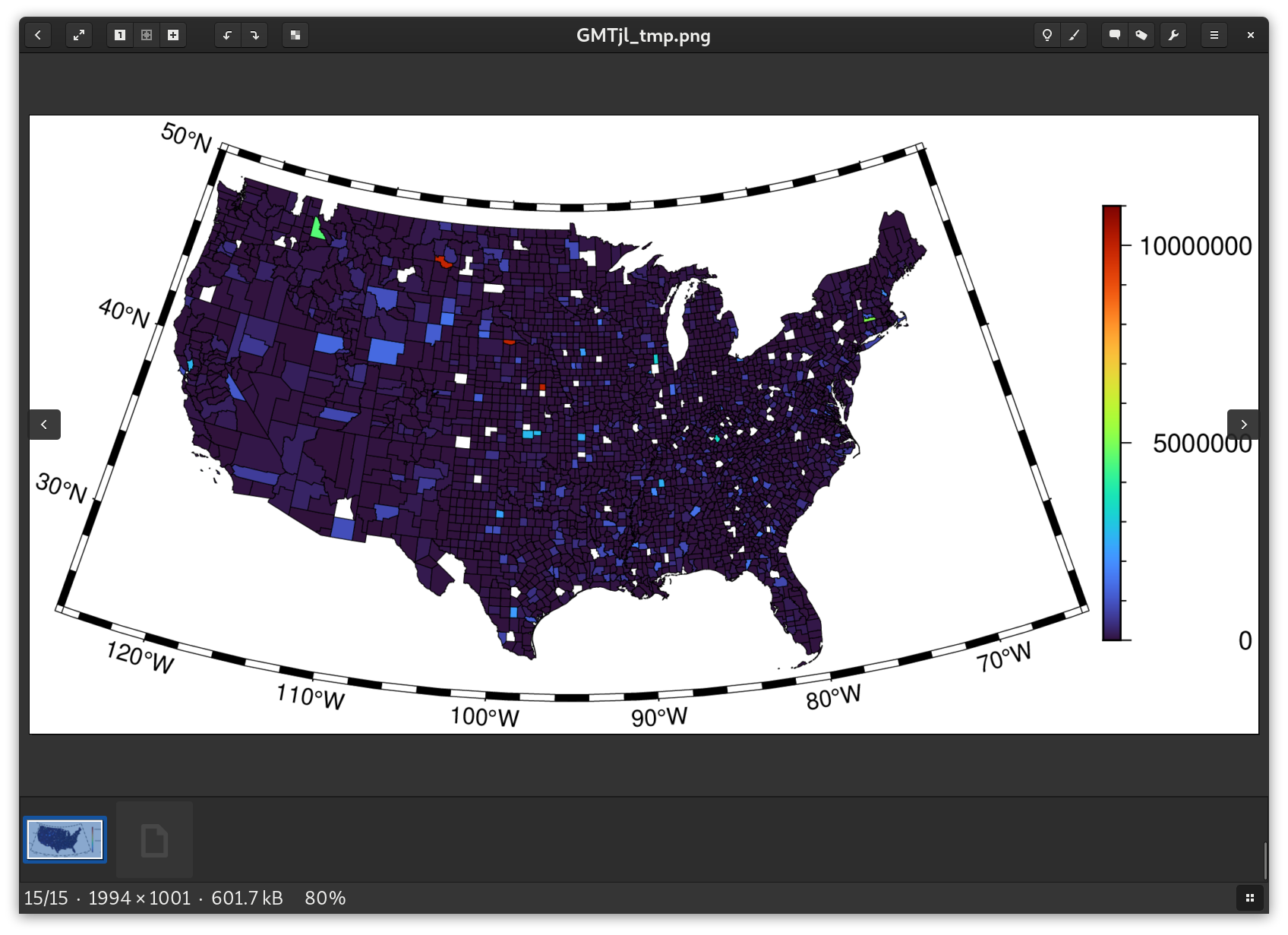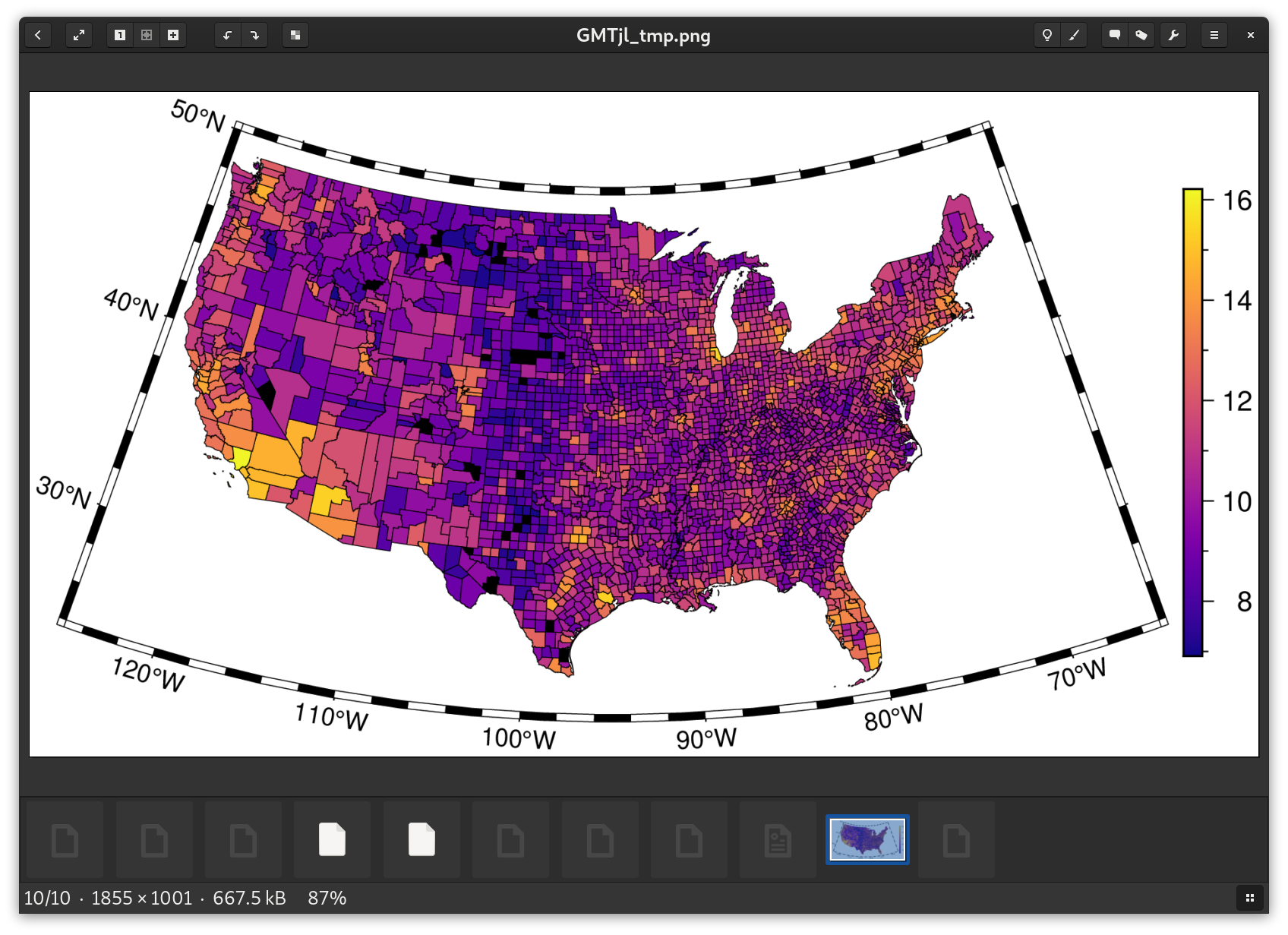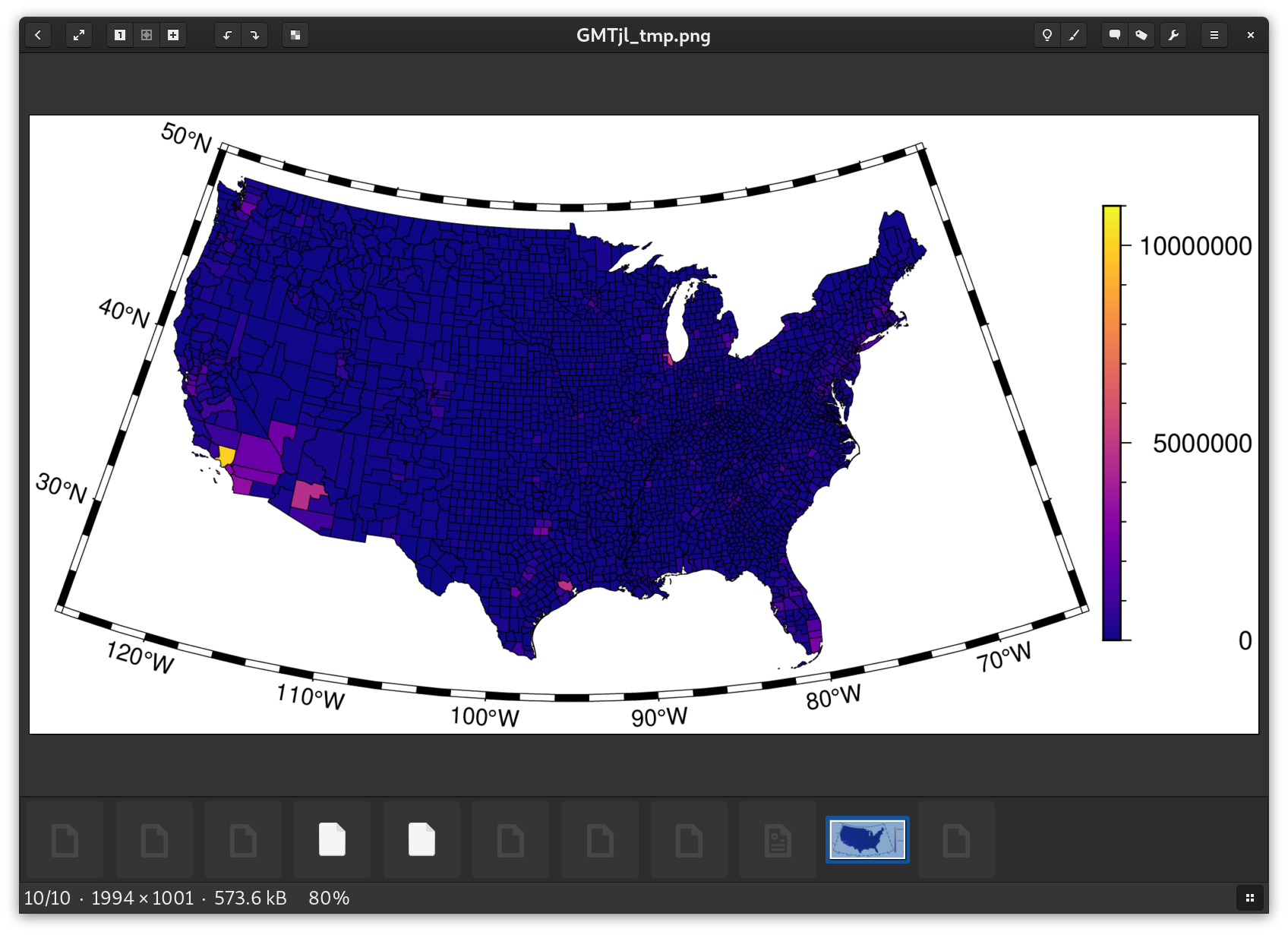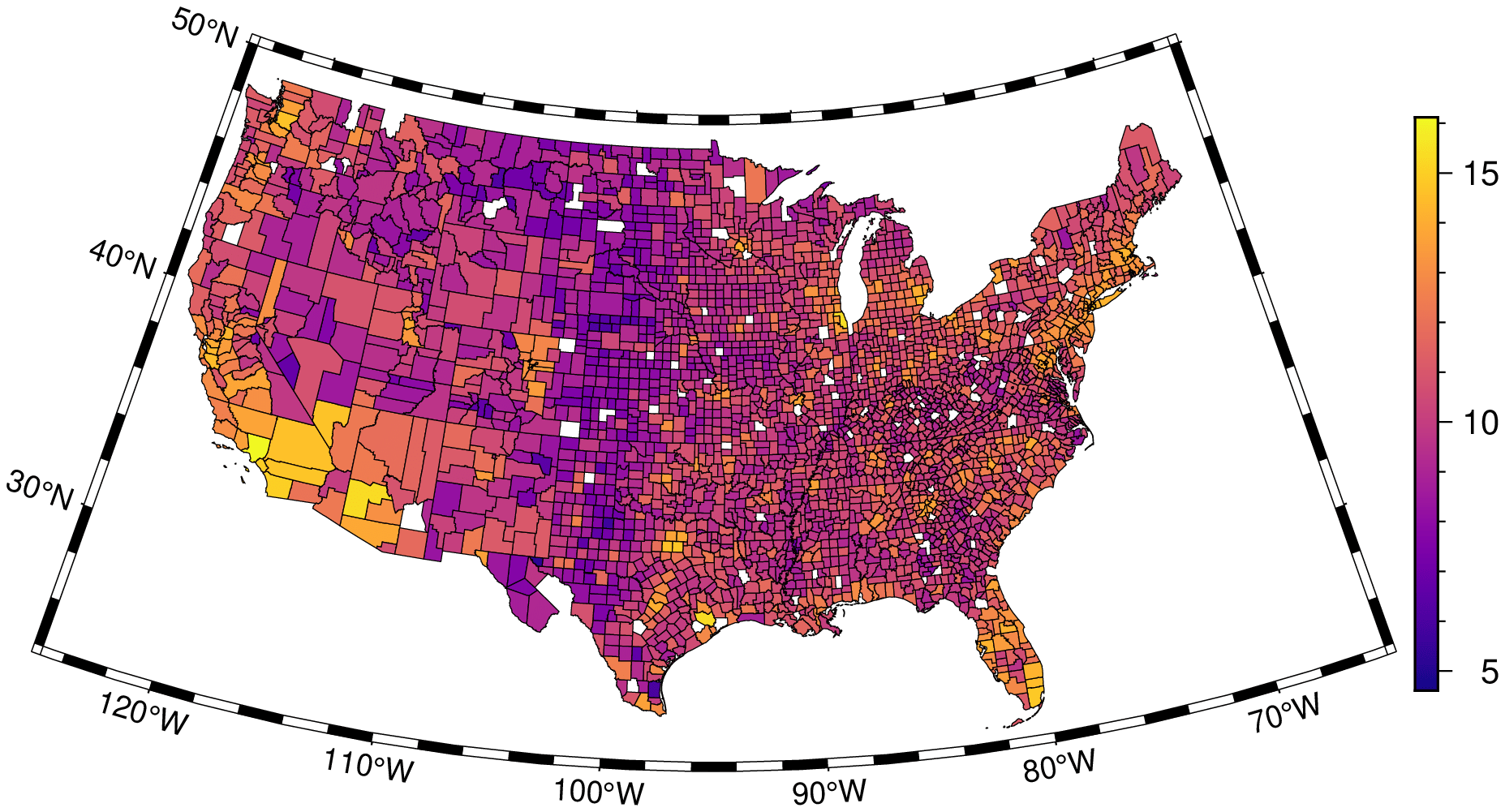Replies: 18 comments 25 replies
-
|
Quick thoughts (@Pwessel)
|
Beta Was this translation helpful? Give feedback.
-
|
My quick attempt with random data worked better than I thought so I'll leave it for you to play with when you have true data |
Beta Was this translation helpful? Give feedback.
-
|
This is going to be interesting between what we think the users should know and what they actually do. Don't have time now to expand (will do in 3-4 hours or tomorrow). Quick answers See the manual https://www.generic-mapping-tools.org/GMT.jl/dev/types/ for the GMT.jl types, namely the See the online help of |
Beta Was this translation helpful? Give feedback.
-
|
Hmm, not sure where to start with this so let me sate the basics and go a bit beyond that. We use x,y[,z] to plot lines, points (or any other symbols) or polygons. All plotting packages can do that by providing the data in files or Mx2[3] arrays. GMT is no exception and accepts input from text files with data as x y [z] or other field separators (e.g. x,y[,z]) in what is generically known as the comma separated values (or CSV). However, the above is a pure Cartesian that suites many usage cases but carries no information about the metadata. Imagine, and that is a very common situation, that the x,y are points in a projection system, UTM for instances. We need then to specify the projection parameters so that the software knows how to plot the data and eventually deals with data in other projection systems. We need then to store that info in the metadata. Think also that data contains the polygons delineating US Counties and we want to keep a trace of their names, area, centroids, zip code, etc. The most traditional format that stores this kind of information is the ESRI shapefiles (but several database formats may also be used) and it stores it in what is known as the attributes table. Those attributes can be anything but I'll stop here I think it's the limits of my knowledge. When GMT reads one of these files via I'll stop here for now and let you come with more questions (we still have to talk about grid and image formats that are the base map data). |
Beta Was this translation helpful? Give feedback.
-
|
Sorry, didn't answer to the colormaps question. Don't know how difficult is to use the colormaps from Colors.jl, probably not much but never looked at it because we have many of them and overall a quite long list in GMT. See |
Beta Was this translation helpful? Give feedback.
-
|
Ok, so here are some more real-world consideration. As you know, when working with real data things get messy! I'm using the dataset at https://www2.census.gov/programs-surveys/popest/datasets/2010-2020/counties/totals/co-est2020-alldata.csv which has county population estimates. In the US county names are not unique, but we have FIPS standards (federal information processing standards) which assign a unique code to each state and to each county in the state... so there are two fields we need to match on. I read in the counties shape file: and I see that counties[1].attrib is a dictionary and I can extract the STATEFP and COUNTYFP values to make a dataset: Now there are several non-matching lines towards the end of the dataset... with missing values...perhaps they correspond to some outlying territories like Guam or something I don't know. If I try to use them gmt doesn't like it: So I try eliminating the missingness: This results in a plot... but it's clearly wrong. For example Los Angeles County is in the lower left of this map, and should have 9M people or so, and yet it is colored dark blue meaning basically less than 1M and some random counties in the middle of the country are colored crazy high populations. |
Beta Was this translation helpful? Give feedback.
-
|
Ok @joa-quim I've pushed a new version with GMTMaps.jmd which includes the code I'm using to make the choropleth. You can see what I'm up to more explicitly. If you want to try to run it, just: |
Beta Was this translation helpful? Give feedback.
-
|
So, the problem is the order of the values in the There is some issue when reading the shapefile that is loosing part of the name when it's a multi words name, but that's something to address latter. |
Beta Was this translation helpful? Give feedback.
-
|
Ok, so this is fantastic because it shows a clear workflow that will be understandable to data analysts and uses general tools such as DataFrames for achieving the necessary data munging. Thank you so much for help with this first example! I think an interesting next question perhaps is how to calculate population density (ie. take the population and divide by the area of the polygon). I assume GMT probably has a way to calculate the polygon area? |
Beta Was this translation helpful? Give feedback.
-
|
Also, suppose I want to save the image to a particular filename. Right now imshow is outputting to /tmp/GMTjl_tmp.png and overwriting the previous thing when I do a new plot. Suppose I want to plot to particular output files say for inclusion into a document or whatever? I imagine there is a keyword argument but I'm not seeing anything obvious in the docs to tell me which one, or perhaps I should be calling a different function to output to a file rather than show it in a window? Finally, is there a way to make the image show up in the output of the "weave" or in a Jupyter notebook etc? |
Beta Was this translation helpful? Give feedback.
-
|
Ah, same fig as mine with a modified version of the Don't mistake me, I like the DataFrames solution and I think it will be a more natural for people used to it but I'm too biased into the internal workings and prefer something more straight to the goal. Slightly different from yours because my colormap is: |
Beta Was this translation helpful? Give feedback.
-
|
For including output into a weave / jmd document, i'm just using |
Beta Was this translation helpful? Give feedback.
-
|
Ok, I have an interesting additional plot type. We can calculate the whole of the population estimate of the US... what is the smallest area that contains 50% of the population? We can plot this as 0,1 variables with a :plasma based cpt. So the question is how to calculate this set of counties... I'm thinking I calculate density, and then order by decreasing density, and then cumsum the populations, and include everything with cumsum less than 50% of total... Will give it a try! |
Beta Was this translation helpful? Give feedback.
-
|
I believe I went through and fixed a number of problems in processing the data, including removing the "000" county (ie. the whole state), and calculating the area of counties that have more than one polygon correctly (by grouping data frames and adding up the areas for given county). The current version should produce valid maps I think. I think this shows choropleth maps pretty well so far. What do you think should be the second kind of map we look at? Maybe something that colors things continuously based on a field like temperature? |
Beta Was this translation helpful? Give feedback.
-
|
Hi, Regarding an example with temperatures I know where o get temperatures for oceans since they are easily measured by satellites but the same is no true for atmosphere. I think the most reasonable source for this is from meteorological models but I have no experience to get that type of data. Anyway, I think you are now aiming for an example that uses grid or image data that I mentioned in one of my first posts. You may want to have a look at RemoteS.jl Gallery in the docs for a some examples on using Satellite data. |
Beta Was this translation helpful? Give feedback.
-
|
Hi, some more changes. |
Beta Was this translation helpful? Give feedback.
-
|
Hi @joa-quim it's been a complicated couple weeks, I will look into some of these things next week after other stuff settles down. thanks for continuing to work on this project! Yes I think next we try some temperature or similar data. I'll see what I can find. |
Beta Was this translation helpful? Give feedback.
-
|
That's fine, no worries. Regarding the temperatures, as I told you sea surface temperatures are easy to find. Atmospheric I think we can't escape from model data. |
Beta Was this translation helpful? Give feedback.






Uh oh!
There was an error while loading. Please reload this page.
Uh oh!
There was an error while loading. Please reload this page.
-
I'd like to create an example Tutorial for using GMT.jl in Julia to do displays of social and scientific data, targeted at people who know something about working with datasets but generally are very naive about terminology, file formats, and specifics of mapping jargon etc.
Some examples of the kinds of things I'm imagining people in the target audience might want to create:
The audience would be people who understand how to use CSV, DataFrames, DataFramesMeta, merging, joining, data munging, regression, maybe simulations etc, but would like to display their data in the context of a spatial display, a map, or a 3D model or something along those lines.
Suggestions are welcome here for specific projects that can be tackled, either using specific datasets, or reproducing specific kinds of visualizations, or just general suggestions of "it'd be nice to see how to..."
@joa-quim welcome and thanks for your help!
Beta Was this translation helpful? Give feedback.
All reactions